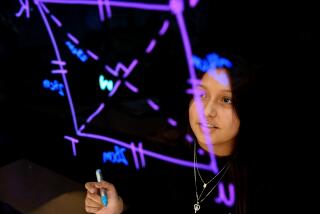RANCHO SANTA MARGARITA : Young Researchers Put Theories to Test
For 16-year-old Jason Forman, it started with his father’s cigarette smoking. In 15-year-old Traci Pichler’s case, it came out of her hopes to go to medical school. David Baird, 15, was moved during his first-ever earthquake. And Darci Dutton has spent countless hours during her 15 years riding in her father’s crazy cars.
Each of these Santa Margarita High School students took those experiences and inspirations and put them to work, transforming them into science projects that are featured in the school’s research exposition and competition.
That part, the seed of an idea, is the toughest obstacle for a student attempting any science project, according to Maureen Leith, the school’s science department chairperson.
“That’s the hardest part, coming up with an idea,” Leith said. “Once they get the idea and have something concrete to work with, they’re usually fine.”
In all, 258 students of the about 900 in the 3-year-old parochial school filled the school’s gymnasium with an assortment of projects which were the result of a common assignment: Come up with a question, form a hypothesis and guess at an answer. The project then should be formulated to test that hypothesis.
Forman, who wanted to show his father what he was doing to himself by smoking, went to the American Lung Assn. They provided him with a set of plastic artificial lungs. From there, Forman hooked the lungs up with a variety of cigarettes to test the different effects of the tar contents.
“You could tell the difference after 15 cigarettes,” said the sophomore from Irvine, pointing to the varied array of darkened lungs.
San Juan Capistrano’s Nichols Institute helped Pichler, a sophomore from Laguna Hills, analyze the differences between AIDS-infected blood and her own. The results showed that AIDS-infected blood had fewer helper and suppressor cells, those used in the body’s immune system.
“That is why AIDS sufferers die of a variety of diseases, because their immune system cannot fight them,” she explained.
Baird, a sophomore from Mission Viejo, could not resist doing something about a new-found experience of his: sitting through an earthquake.
“We just moved here from Pennsylvania about four years ago,” he said. “Before that, I had never felt an earthquake before.”
With the help of a generator provided by his father, Baird found that gravel is often more stable than soil or sand when tested by vibration.
Dutton, a freshman from Newport Beach, has first-hand knowledge of riding in a variety of cars her father collected, from a Model T to a Ferrari. So she rigged up an aerodynamics test pitting a 1929 Ford “Woody” against a Aerotech Oldsmobile.
The Oldsmobile, because of its sleek design, proved to be a lot more dynamic than the boxy woody.
All of the projects were judged by a jury of 50 parents and teachers, with the winners moving on to the county competition.
“Many people feel we are in the midst of a science crisis,” Leith said. “At Santa Margarita the students are working on scientific research that we hope can make a difference in their lives as well as improve the lives of others.”
More to Read
Sign up for Essential California
The most important California stories and recommendations in your inbox every morning.
You may occasionally receive promotional content from the Los Angeles Times.










